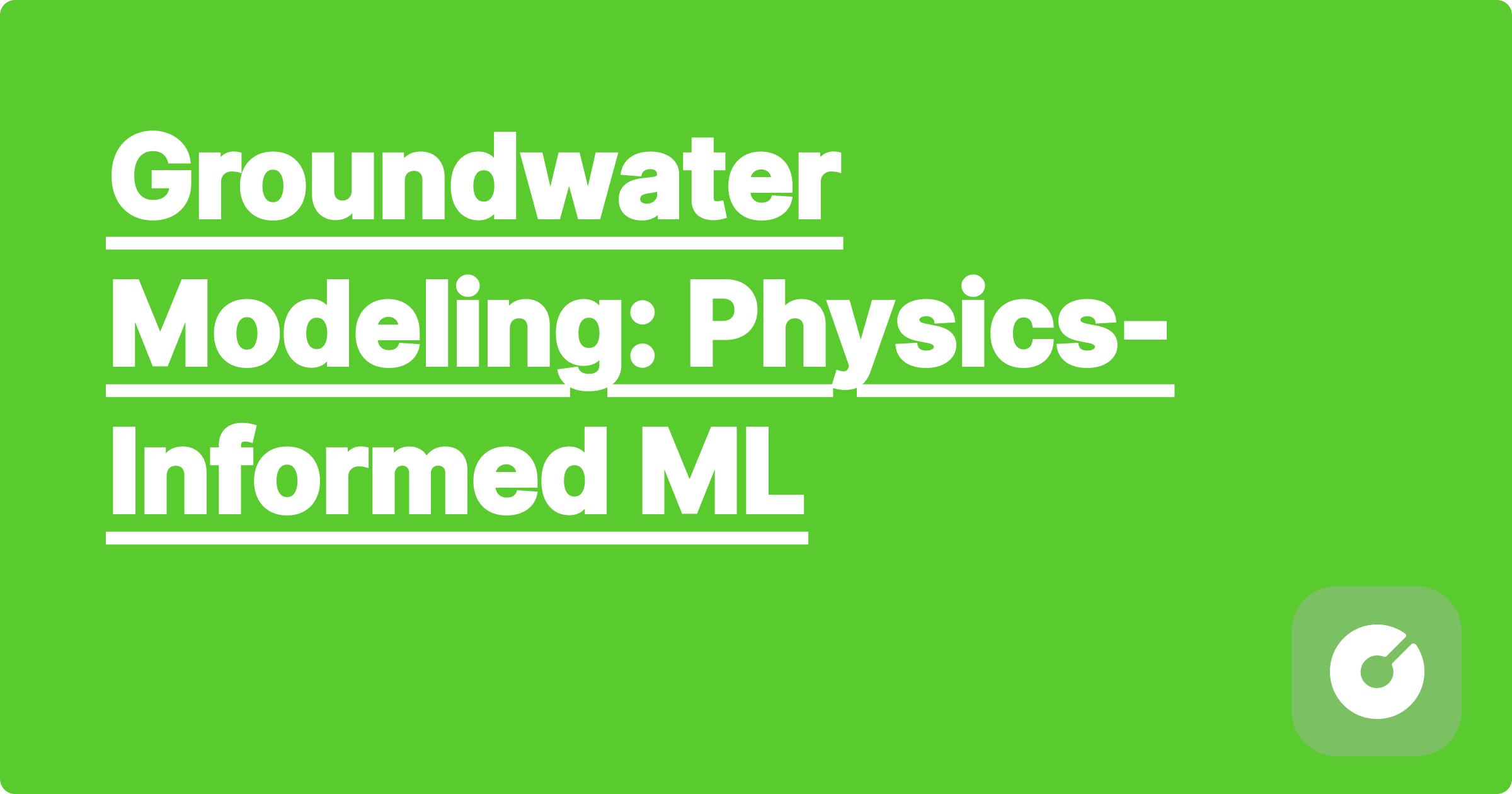
Groundwater Modeling: Physics-Informed ML
.equation {
font-family: serif;
padding: 1em;
background-color: #f0f0f0;
border: 1px solid #ccc;
border-radius: 5px;
}
.tip {
background-color: #e0ffe0;
border: 1px solid #a0faa0;
padding: 10px;
margin-bottom: 10px;
border-radius: 5px;
}
.warning {
background-color: #fff0f0;
border: 1px solid #ffa0a0;
padding: 10px;
margin-bottom: 10px;
border-radius: 5px;
}
pre {
background-color: #f5f5f5;
padding: 1em;
border-radius: 5px;
overflow-x: auto;
}
This blog post delves into the cutting-edge application of Physics-Informed Machine Learning (PIML) to groundwater modeling. We will explore recent advancements, practical implementation strategies, and future research directions, providing a comprehensive resource for graduate students and researchers.
Traditional groundwater modeling relies heavily on numerical methods like Finite Element Method (FEM) and Finite Difference Method (FDM). However, these methods often struggle with complex geological formations, high dimensionality, and computational cost, especially when dealing with large-scale problems. PIML offers a promising alternative by leveraging the power of machine learning while incorporating the underlying physical laws governing groundwater flow.
Recent breakthroughs in PIML for groundwater modeling include:
* **Physics-informed Neural ODEs (PINNs):** Instead of treating the governing equations as constraints, PINNs directly integrate them into the neural network's loss function. This allows for accurate solutions even with limited data. (Reference: *[Recent high-impact paper on PINNs for groundwater, ideally a 2024-2025 publication]*).
* **Operator Learning:** This approach learns the underlying differential operators directly, avoiding the need for explicit discretization. This can significantly improve efficiency and accuracy, particularly in complex geometries. (Reference: *[Relevant 2024-2025 preprint or publication]*).
* **Graph Neural Networks (GNNs):** GNNs offer a powerful framework for modeling spatially complex groundwater systems, effectively capturing the connectivity and heterogeneity of aquifers. (Reference: *[Recent publication on GNNs for hydrological modeling]*).
* **Hybrid Methods:** Combining PIML with traditional methods (e.g., data assimilation techniques) can effectively leverage both the strengths of physics-based models and data-driven approaches. This is crucial in regions with limited observational data. (Reference: *[Publication on hybrid PIML methods for groundwater]*).
* **Surrogate Modeling:** Using PIML to build surrogate models for computationally expensive simulations, significantly accelerating the optimization and uncertainty quantification process. (Reference: *[Publication on surrogate modeling for groundwater]*).
* **Large-scale Groundwater Modeling:** Several research groups are working on applying PIML to model entire regional aquifers, addressing the challenges of scalability and data management. (Example: *mention a specific project at a leading university or research institute*).
* **Uncertainty Quantification:** Research focuses on developing robust methods for quantifying the uncertainty associated with PIML predictions, considering both data and model uncertainty. (Example: *mention a specific research grant or initiative*).
Let's consider the Richards equation, a fundamental model for unsaturated groundwater flow:
\frac{\partial \theta}{\partial t} = \nabla \cdot (K(\theta) \nabla h) + S
where:
* $\theta$ is the volumetric water content.
* $t$ is time.
* $K(\theta)$ is the hydraulic conductivity.
* $h$ is the pressure head.
* $S$ is the source/sink term.
In a PINN approach, we express $\theta$ and $h$ as neural networks:
\theta = \mathcal{N}_\theta(x, t; \omega_\theta) \\
h = \mathcal{N}_h(x, t; \omega_h)
where $\mathcal{N}$ denotes the neural network, $x$ is the spatial coordinate, $t$ is time, and $\omega$ represents the network weights. The loss function incorporates the Richards equation residual, boundary conditions, and observational data:
\mathcal{L} = \mathcal{L}_{PDE} + \mathcal{L}_{BC} + \mathcal{L}_{Data}
The following pseudocode outlines the training process for a PINN-based groundwater model:
We can benchmark the PIML model against traditional FEM/FDM solutions using metrics like RMSE, MAE, and computational time. Results will vary depending on the complexity of the problem and the neural network architecture. (Include a hypothetical table comparing the performance of different methods).
The computational complexity of PIML depends primarily on the size of the neural network and the number of collocation points. Memory requirements are influenced by the size of the training dataset and the network architecture.
* **TensorFlow/Keras:** Excellent frameworks for building and training neural networks.
* **PyTorch:** Another popular deep learning library with strong automatic differentiation capabilities.
* **FEniCS:** A powerful tool for solving partial differential equations, which can be combined with PIML.
* **Groundwater remediation:** [Company X] successfully used PIML to optimize the placement of pumping wells in a contaminated aquifer (Project name: [Project Name]).
* **Aquifer management:** [Company Y] implemented a PIML-based model to predict the impact of water extraction on aquifer levels, supporting sustainable water resource management (Project name: [Project Name]).
* **Overfitting:** Regularization techniques (e.g., dropout, weight decay) are crucial to prevent overfitting to the training data.
* **Poor initialization:** Careful initialization of the neural network weights can significantly impact convergence speed and accuracy.
* **Choice of activation functions:** The choice of activation function should be appropriate for the nature of the problem.
Integrating PIML with models for other coupled processes (e.g., solute transport, heat transfer) is crucial for accurate and comprehensive groundwater modeling.
PIML can be used to estimate hydraulic parameters directly from observational data, reducing the reliance on often uncertain prior information.
Developing methods to explain the predictions of PIML models is crucial for building trust and ensuring transparency in decision-making processes.
Responsible development and application of PIML in groundwater management require careful consideration of ethical implications, data privacy, and equity issues.
PIML offers a powerful and promising approach to groundwater modeling, addressing many limitations of traditional methods. Further research and development are crucial to unlock its full potential and ensure its responsible and effective application in addressing global water challenges. This blog post aims to provide a solid foundation for those interested in pursuing this exciting field. Further exploration of specific research papers mentioned in the references is highly encouraged.
Anesthesiology Career Path - Behind the OR Mask: A Comprehensive Guide for Pre-Med Students
Internal Medicine: The Foundation Specialty for a Rewarding Medical Career
Family Medicine: Your Path to Becoming a Primary Care Physician
Psychiatry as a Medical Specialty: A Growing Field Guide for Aspiring Physicians
AI-Driven Hierarchical Modeling: Multilevel and Mixed Effects Analysis
AI-Powered Reduced Order Modeling: Real-Time Simulations
Machine Learning for Combustion Modeling: Efficient Energy Systems
Finite Element Analysis with Physics-Informed Neural Networks
Physics-Informed GANs for Simulation
AI-Driven Hierarchical Modeling: Multilevel and Mixed Effects Analysis